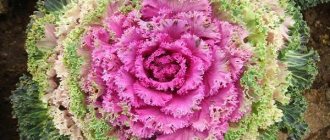Maiden's grape or Vichi is used to form hedges, decorate fences, camouflage unsightly buildings and decorate gazebos and verandas. On a sunny day, in a gazebo entwined with leafy vines there will be shade in which you can hide from the hot midday sun. In addition, the plant has attractive flowers and fruits that can decorate any area. In order for Vici grapes to grow well and quickly, they must be planted and cultivated correctly. We will talk in detail about proper planting and care nuances in our article.
Maiden grape vicha
author Velikanova S.I., photo by the author
The maiden triacum Vicha form is a beautiful deciduous vine growing in our garden.
I would like to share with readers of the Gardenia.ru website my experience in growing and propagating Vicha grapes.
The homeland of the triacid grape is Japan, China, the Korean Peninsula, and southwest Primorye.
Tripointed maiden grape (Parthenocissus tricuspidata) or ivy grape is a fairly frost-resistant perennial vine from the grape family.
The flowers of the tripoint grape are modest, and the small blue-violet fruits on red clusters are inedible. For gardeners, the main attraction of this plant lies in its beautiful leaves.
Garden forms of triacid grapes
The maiden triacum vine has decorative garden forms, which are valued for their unusual leaf configuration and beautiful color - not only in autumn, but throughout the entire season.
For example, the purple ivy vine (f. purpurea) has attractive dark purple leaves, while the golden vine (f. aurata) has yellow spots on its green leaves.
Maiden grape Vicha (f. veitchii) is the most common garden form of this species. This liana has small smooth leaves, dense and leathery, with a beautiful shape. They are usually whole, three-lobed, ivy-like, or 2-3-leafed.
In the summer, the leaves of the triacid Vicha grape are dark green, and in the fall they turn bright orange-red. After the leaf fall is over, the graceful shoots of the vine are clearly visible, which are also a kind of decoration.
Features of care
Caring for Vichi grapes includes regular timely watering, weed removal, fertilizing and pruning vines.
The plant should be watered only three to four times per season , but if the summer is hot and dry, more frequent watering will be needed. Each bush will need one bucket of water.
At the beginning of summer, the vine is fed with nitrophoska, and at the height of growth in the middle of the season - with complex fertilizers with minerals. After watering, the beds with plants are freed from weeds and loosened. Bare roots are covered with earth.
Mulch, which can be spread around the plants, will help retain moisture, nourish the bushes and prevent weeds from growing . To do this, you can use peat , humus or compost, spreading them in a layer six centimeters thick.
Pruning vines
When caring for Vici grapes, branches are pruned throughout the season, with the help of which the plant is formed. In summer, green shoots can be pruned, and woody branches can be pruned in autumn.
When propagating by seeds in the first three years, pruning may not be necessary, since the plant is still small at this time. Subsequently, the shoots are removed in order to form a reasonable density and a certain shape of the bushes. The cut using pruning shears should be made over a healthy kidney.
After the formation of the main skeletal branches, in the future, when caring for the vine, you will only need to limit the growth of shoots and carry out sanitary pruning. The bushes should not be allowed to grow too much, otherwise they will turn out to be ugly, sloppy thickets.
Caring for Vici grapes in winter
In warm regions, the tripoint vine overwinters well. But in areas with little snow and cold winters, it may die. To protect it from freezing, you should first lay mulch under the bush, and then spruce branches and plant lashes. The branches are covered with spruce branches on top . At the same time, you need to make sure that the bush does not dry out on warm days.
Maiden grapes Vicha in landscape design
Vicha virgin grapes as an ornamental plant are widely used in gardens and parks in the Far East, Krasnodar Territory, the Caucasus, the Baltic States, Ukraine and many European countries with mild climates.
In favorable conditions, the length of this beautiful vine reaches 39 meters! During the gardening season, its fast-growing shoots grow 3-4 meters.
In the photo: Vicha grapes on a vertical support and in the form of an ampel
Ivy-shaped grapes of the Vicha form are used for vertical gardening of house walls, fences, and decorating balconies.
This tenacious vine easily climbs any support thanks to its branched tendrils. Its shoots are secured with the help of suction cups, the ends of which have swellings. From them, upon contact with a hard surface, an adhesive substance is released that firmly holds the vine on any surface - without any additional garters, the use of wire or mesh. Therefore, using this spectacular plant, you can decorate a house without any hassle, cover a garden shed and utility block with a “green screen,” plant trees on any fence, or create a thick cover for a gazebo.
Vicha grapes planted on a retaining wall behave like a hanging plant, sending shoots down.
If necessary, this beautiful vine can also be grown as a ground cover plant. In this case, Vicha grapes grow 3 meters wide and form a dense leafy carpet about 25 cm high on the ground, through which it is difficult for weeds to break through.
The roots of the Vicha maiden grape do not go deep into the ground, so this plant can be grown in containers.
By layering
With the onset of spring, it is necessary to select about five young lashes, each of which has several unopened buds. We dig them in several places into pre-prepared grooves, the depth of which should be at least 5 centimeters. The ends should be pinned to the ground with a special garden pin or wire. As a last resort, you can use a slingshot branch. We leave the end of the lash outside untouched. After this, all that remains is to thoroughly water such a seedling. In 3-4 months you will receive several full-fledged plants with a developed root system, which will be ready to be transplanted to a new location.
Growing and propagating Vicha grapes
Maiden grape Vicha is undemanding to soil. It grows well in the sun and is shade-tolerant - even suitable for full shade. Therefore, in any garden you can find a suitable place for this ornamental plant.
When growing lianas in urban conditions, it is important that the tripoint grapes of the Vicha form are resistant to exhaust gases, smoke and dust.
I love this plant very much and propagate it for my garden and for other gardeners.
Tripointed Vicha grapes are easily propagated by seeds, root suckers and cuttings. This vine is also used as a rootstock for other forms and types of grapes.
It is better to sow Vicha grape seeds extracted from ripened fruits in the fall immediately to a permanent place, deepening them by 7 mm.
When sowing in spring, a 2-3-month stratification of the seeds is first carried out at a temperature of +3...+5 degrees.
In the first year, Vicha grape seedlings must be fed so that the young plants develop faster and have time to get stronger before the onset of autumn cold. I water them twice a week and carefully loosen the soil around the growing vine.
Tripointed Vicha grapes can die in a cold winter with little snow. It is advisable to cover a young vine with leaves for the winter to protect it from freezing.
Weekly Free Digest of the Gardenia.ru Site
Every week, for 10 years, for our 100,000 subscribers, an excellent selection of relevant materials about flowers and gardens, as well as other useful information.
Plant care
The plant needs annual pruning
Watering Vicha grapes is carried out at intervals of a month. If the plant is grown in a hot climate (central and southern regions of the country), the interval is reduced to 2 weeks. It is better to water the plant in the morning, while the sun has not risen high. 10 liters of warm water are poured under each tripointed bush. After 2-3 days, loosen the soil and destroy all weeds.
Features of feeding
Tripointed grapes of the Vichi variety need high-quality fertilizing. 20 days after planting, nitrophoska is applied under the plants (100 g for each bush). During the period of active growth, fertilizing consists of using phosphorus components (40 g of superphosphate per 10 liters of water). When fruit sets, the bushes are watered with a solution of ammonium nitrate (30 g of the drug per 10 liters of water).
Trimming
Shoots of the Vichi variety require annual pruning: it allows the formation of bushes. In the summer, green shoots are removed, and in the fall, all diseased and damaged areas are cut off. The desired number of eyes is left on each shoot.
In late autumn, the entire plant is covered with plastic film or agrofibre to prevent frost from damaging the structure of the bush.
and whether in the ivy plant, Boston ivy
- a wonderful liana for your garden. In its beauty and unpretentiousness it surpasses many perennial vines. China, the Korean Peninsula, and Japan are considered to be the birthplace of triacid grapes.
This vine climbs onto any surface thanks to branched tendrils that have peculiar suction cups with swellings at the ends. When they come into contact with a hard surface, an adhesive substance appears on them and the vine is held on any surface without any additional garters, mesh or wire. The beauty of this grape is that it crawls along the wall itself, clinging to it with its “hands.” (But it doesn’t stick to polycarbonate, we have a greenhouse made of this material, and the vicha doesn’t want to stick to it, so you only need to plant it near natural materials)
With the help of these grapes it is easy to decorate a house, fence or barn.
The vine has few roots and can even be grown in a container.
Grows quite quickly, difficult to keep
if the area is small, you need to trim it, otherwise it will tighten everything up. During the season, the Vicha grape vine can grow four meters under favorable conditions.
It can even be planted as a ground cover. It looks very beautiful, grows into a thick carpet, does not allow weeds to pass through, very convenient if it is not possible to plant a lawn.
This species is resistant to smoke and exhaust gas, so it can be planted next to roads.
Grows in any conditions - both in the hot sun and in the deepest shade.
Quite frost-resistant, although in very cold snowless winters it may partially freeze. In our climate (southern Russia), in recent years the vines cannot withstand just such winters, but in the summer they are restored and actively grow again. In more northern areas, it is recommended to remove the vine from its support and leave it on the ground under the snow.
Propagation of Vicha grapes
seeds, root suckers and cuttings. Seeds need to be stratified for a month at a temperature of 5 degrees. Cuttings do not take root well, and if you have little experience in cuttings, it is better to purchase ready-made seedlings. But you can try layering; even canes that just lay on the ground will take root, especially if you pin them down and provide good watering. They also propagate by grafting onto ordinary girl grapes, if you are involved in grafting, then it’s worth it
Planting, care
Maiden grapes are not particularly picky about soil. It can grow on any side: south, north, east or west. Of course, on the western and northern sides the leaves may be small in size, and their color will not change until frost. The grapes grow fully on the sunny side.
It is customary to plant girlish grapes in the spring - in April and May. Grapes are also planted in the fall: in September, October. Before planting, the soil needs to be dug up properly.
To improve the growth of the seedling, it is necessary to feed it. They do this several times a season. The first feeding should be planned for spring. For one cubic meter it is necessary to add 40-50 grams of nitroammophoska. When the grapes begin to grow, 100-200 grams of fertilizer called “Kemira Universal” should be applied. Triacum vines are fertilized with potassium fertilizers in the fall. You can use potassium magnesia or stove ash. For rapid shoot growth, it is customary to fertilize the plant with aquamarine (about 50 grams per square meter).
In dry summers, young seedlings should be watered frequently
During drought, grapes need to be watered. In a normal summer there is no need to water often; rain is enough for it.
It must be remembered that virgin grapes are primarily suitable for vertical gardening. If you need to decorate a very large surface, then let the grapes grow as they please.
You should immediately monitor the desired shape of the grapes.
When forming maiden grapes, use the following tips: secure the young shoots to a support (this can be a wall or fence), and then point them in the desired directions; if you cannot cope with an unruly shoot, you can immediately remove it; weak, damaged and thickening shoots must be removed - this is called sanitary and restraining pruning.
Be sure to periodically loosen the grapes, fight weeds, and remove dry and unnecessary leaves. The growth of grapes can be controlled by tying them in the right way. You can trim the grapes to reduce their volume.
If you acquire Vicha grapes, you will not regret it at all. This perennial vine is so superior to ordinary virgin grapes. Especially in winter, when a simple girl’s dress looks unpresentable, vicha looks like a neat tree with a very beautiful pattern of branches painted on the wall. In summer it is a thick wall of leathery three-lobed leaves. In autumn - gorgeous colors from dark red to golden bronze.
Click on the pictures and read interesting things on the site
Reviews
Michael
I really like wild grapes, as they decorate beautifully. But, however, this is a difficult plant, because it grows very quickly, and it needs to be trimmed very often, otherwise it will spread throughout the garden. If the hedge or wall you want to decorate is small, then it is better to plant a less aggressive plant. For example, some other grapes or liana-like shrubs, less tall. Wild grapes are capable of crushing everything - neighboring trees, roofs, drainpipes. Long, heavy vines have destructive power, as their suckers penetrate into various cracks, under tiles, and so on. Moreover, not every support can withstand the weight of 10-meter branches. Maiden grapes are more suitable for large-scale compositions, when you want a lot of greenery quickly and quickly. In small areas it is better to plant other plants.
Anastasia
These grapes have been growing at the dacha for about 20 years now. They have completely encircled the house with their long vines. Many people say that the vine spoils the roof and other elements of the building, but our house is brick, and I assure you that the brick does not deteriorate. I also know that powerful vines reliably protect walls from dampness and drafts. Unpretentious, fast-growing and never getting sick, grapes are not much of a hassle. All that is needed is to trim the branches in time.
Botanical characteristics
Maiden grape triacum is a tree-like vine, a climbing woody plant with relatively thin stems. It grows 15-20 m long. The foliage is trilobed, 10-20 cm long, has large teeth along the edges, and a shiny surface.
Depending on the season, some plant species change color. In summer, dark green becomes carmine red as autumn approaches. At the ends of the tendrils there are disk-shaped extensions, with the help of which the plant clings to the bark and vertical surface.
The second name of the grape vine is maiden ivy grape.
This is a perennial plant. Its growing season is about 157 days and covers the period from May 12 to October 15. The inflorescences are corymbose, small, pale, green-yellow. The flowering stage occurs in mid-June to early July.
The berries are formed without pollination, which is why the grapes are called maiden, or virgin. The fruits of the maiden triostrine vine are blue-black in color and have a waxy coating on the surface. The berries grow up to 6-8 mm in diameter, each weighing about 7 g, and has 1-2 seeds. The fruits are inedible and are used only for decorative purposes.
Varieties
In nature there are 3 varieties of virgin grapes:
- Purple. Has purple leaves.
- Golden. There are golden spots on the foliage.
- Vicha. Most common in landscape design, it changes the color of foliage.
Spreading
The main part of the plants grows:
- in China, including the eastern provinces of Anhui, Hebei, Fujian and Henan, in the northeastern region of Liaoning,
- in Japan, including on the islands of Hokkaido and Honshu, Shikoku and Kyushu,
- In Korea,
- in Taiwan.
In Russia, the plant grows in the Primorsky Territory
In Russia, it is possible to see tripointed girlish grapes on the southern side of the Primorsky Territory.
Preferred places of growth in the natural environment are steep cliffs and cliffs on sea coasts. When grown artificially, grapes are gas and smoke resistant.
Practical use
The plant has been cultivated since 1862. The main areas of practical application of triacid grapes are traditional medicine and landscape design.
Medicine
It is believed that the plant has phytoncidal and antimicrobial properties, which is why it is planted to purify the air from microbes and is used externally for inflammatory processes and violations of the integrity of the skin.
Landscape design
Maiden grapes have found wide use in decorating garden plots, thanks to their bright, dense foliage, frost resistance and active growth. The plant is capable of increasing its length to 3-5 m in one growing season.
It is used to decorate the walls of buildings, decorate garden gazebos, and fences. Grape shoots easily cling to any surface using natural suction cups with an adhesive substance.
The variety of tri-accented maiden grape Vinca has found wide use in gardens and park areas of the Krasnodar Territory, in the Far Eastern region and many European countries.
If necessary, the vine is grown as a ground cover, and the plant grows up to 3 m wide, forming a dense living carpet up to 25 cm high on the surface of the earth. It is permissible to grow the crop in a limited space in a living room, since it has a shallow penetration into the soil soil root system.
How to stop the growth of vines
If you need to stop the growth of the vine, you should definitely prune and trim it in the fall. Also, with the help of pruning, they fight those branches that have been damaged by parasites, pests of virgin grapes, or simply withered away. It is imperative to make the correct cut so that further growth really stops.
The branches are cut strictly only with sharp scissors; pruning shears are ideal for this. It is important to choose the right place - about 1-3 centimeters after the grape eye. The cut should not be straight; it is made at an angle of about 45 degrees.
Pruning of vines should be done regularly, otherwise, otherwise, you risk getting overgrown grapes that grow far from where you planned.
It is also worth saying that grapes do not tolerate proximity to other plants, since its root system is so well developed that it does not allow anything else to grow nearby.











